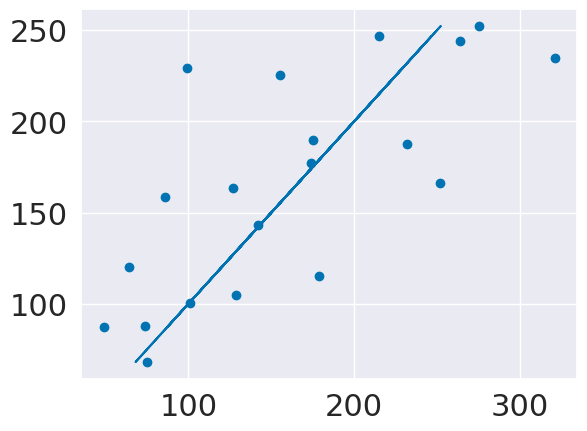Interpretting Regression
Contents
21. Interpretting Regression#
import matplotlib.pyplot as plt
import seaborn as sns
import numpy as np
import pandas as pd
from sklearn import datasets, linear_model
from sklearn.metrics import mean_squared_error, r2_score
from sklearn.model_selection import cross_val_score
from sklearn.model_selection import train_test_split
from sklearn.preprocessing import PolynomialFeatures
sns.set_theme(font_scale=2,palette='colorblind')
21.1. Multivariate Regression#
We can also load data from Scikit learn.
This dataset includes 10 features measured on a given date and an measure of diabetes disease progression measured one year later. The predictor we can train with this data might be someting a doctor uses to calculate a patient’s risk.
# Load the diabetes dataset
diabetes_X, diabetes_y = datasets.load_diabetes(return_X_y=True)
X_train,X_test, y_train,y_test = train_test_split(diabetes_X, diabetes_y ,
test_size=20,random_state=0)
X_train.shape
(422, 10)
regr_db = linear_model.LinearRegression()
regr_db.__dict__
{'fit_intercept': True, 'copy_X': True, 'n_jobs': None, 'positive': False}
We have an empty estimator object at this point and then we can fit it as usual.
regr_db.fit(X_train,y_train)
LinearRegression()In a Jupyter environment, please rerun this cell to show the HTML representation or trust the notebook.
On GitHub, the HTML representation is unable to render, please try loading this page with nbviewer.org.
LinearRegression()
This model predicts what lab measure a patient will have one year in the future based on lab measures in a given day. Since we see that this is not a very high r2, we can say that this is not a perfect predictor, but a Doctor, who better understands the score would have to help interpret the core.
regr_db.__dict__
{'fit_intercept': True,
'copy_X': True,
'n_jobs': None,
'positive': False,
'n_features_in_': 10,
'coef_': array([ -32.30360126, -257.44019182, 513.32582416, 338.46035389,
-766.84661714, 455.83564292, 92.5514199 , 184.75080624,
734.91009007, 82.72479583]),
'rank_': 10,
'singular_': array([1.95678408, 1.19959858, 1.08212757, 0.95268243, 0.79449825,
0.76416914, 0.71267072, 0.64259342, 0.27343748, 0.0914504 ]),
'intercept_': 152.391853606725}
We can look at the estimator again and see what it learned. It describes the model like a line:
except in this case it’s multivariate, so we can write it like:
where \(\beta\) is the regr_db.coef_ and \(\beta_0\) is regr_db.intercept_ and that’s a vector multiplication and \(\hat{y}\) is y_pred and \(y\) is y_test.
In scalar form it can be written like
where there are \(d\) features, that is \(d\)= len(X_test[k]) and \(k\) indexed into it. For example in the below \(k=0\)
X_test[0]
array([ 0.01991321, 0.05068012, 0.10480869, 0.0700723 , -0.03596778,
-0.0266789 , -0.02499266, -0.00259226, 0.00370906, 0.04034337])
We can compute the prediction manually:
sum(regr_db.coef_*X_test[0]) + regr_db.intercept_
234.91095893227003
and see that it matches
regr_db.predict(X_test[:2])
array([234.91095893, 246.81176987])
regr_db.score(X_test,y_test)
0.5195333332288746
We can also look at the residuals and see that they are fairly randomly spread out.
y_pred = regr_db.predict(X_test)
plt.scatter(y_test,y_pred)
plt.plot(y_pred,y_pred)
[<matplotlib.lines.Line2D at 0x7fdf4d8b7040>]

21.2. Questions After Class#
21.2.1. Is there a way to calculate p value in addition to r^2?#
The \(R^2\) is a measure of the quality of the regression fit, but a p-value is not. A p-value implies a broader experimental framework, so it is not included in this object. sklearn does have tools that will calculate a p-value when appropriate, but it not built into this estimator object. The scipy.stats.linregress estimator does compute a p-value, and allows you to specify under which statistical test you want that p-value computed (two-sized, one-sided greater, or one-sided lesser).
Broadly, p-values are very frequently misinterpretted and misused. Their use is not common in ML (because they’re usually not the right thing) and being actively discouraged in other fields (eg psychology) in favor of more reliable and consistently well interpretted statistics.

